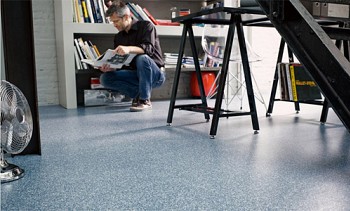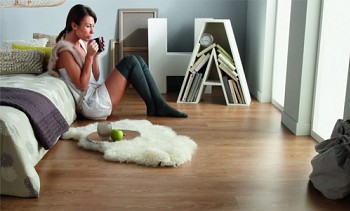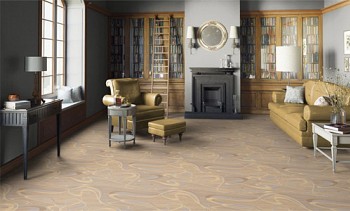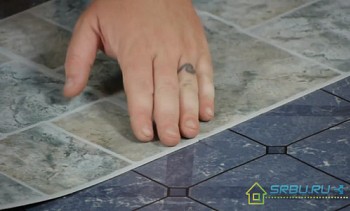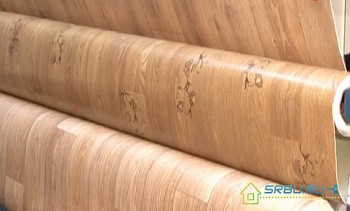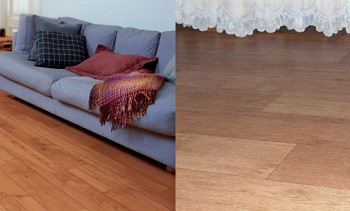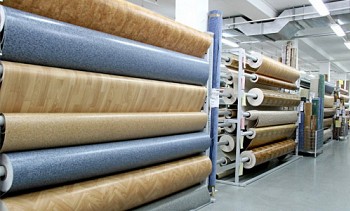Paul from linoleum, of course, is very practical. It looks, of course, simpler than the now fashionable laminate, but it does not get wet and is not afraid of scratches. Yes, and it costs much less than laminated flooring, and it is quite easy to lay it on your own, without attracting hired workers. This will save money in your wallet, allowing you to spend it on something more necessary and useful. Next, you can read how to lay linoleum with your own hands, and what you need to prepare for this. The main thing is to cut the material so that it matches the configuration of the room.
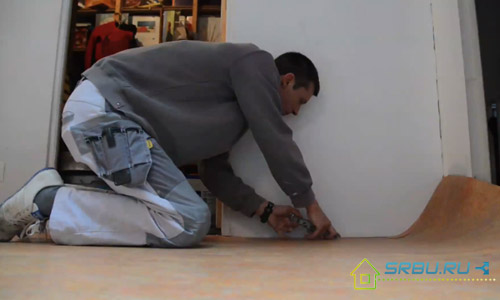
First of all, we are preparing the foundation
So that linoleum does not rub quickly, it must lie on an even plane. After all, even small tubercles or pits can give the floor an aesthetic appearance. In addition, elastic linoleum in these places will either stretch or sag, quickly wearing out, which is not very good.
Before you lay the linoleum coating, you must carefully remove all the skirting boards - after all, linoleum must lie close to the walls. Sometimes skirting boards are still quite suitable, and they can well be put back. In this case, removing them, you must try not to damage. In order not to confuse where to attach what, each plinth of the skirting board, when removing, must be numbered. We put the same number at the bottom of the wall - such a simple way will save a lot of time.
1. First, consider how to lay linoleum on a wooden surface. This can be, for example, parquet that has lost its appearance with falling parquet floors, or painted floors from boards, which have become wavy from time to time. These two types of wooden bases for linoleum are mainly found. They, alas, cannot boast of smoothness, so laying linoleum on them requires mandatory leveling of the base. There are several options for this:
- Wooden floors can be machined with a planer or grinder. All cracks and irregularities are covered with putty, and then polished.
- On the floor from above you can lay a new coating, it can be a fiberboard, chipboard or even multilayer plywood.
- Parquet strips that are missing can be restored, and then the parquet can be recycled.
- A perfectly flat surface can be achieved using bulk floor technology. For this, a special composition is used, called leveling.
2. A concrete base also requires leveling. The methods used are different.
- The base is covered with plywood flooring (wood chipboards or fiberboards can also be used for this purpose).
- A concrete screed with self-leveling properties is used.
3. If you have to lay linoleum where there was a carpet, then you need to not only remove this coating, but also clean the base well from pile and dirt. Those places where the floor remains not very smooth should be treated with a special solution until the proper result is achieved.
4. Ceramic tiles before laying linoleum, on the contrary, do not need to be removed. But if several tiles had time to fall off, they should be glued into place. After that, the surface is poured with a leveling mixture, which has good adhesive properties.
5. Linoleum coating can well be put on an old similar. But only if it does not have holes and cracks, and also if it is not too thick. The main thing is to degrease all the old linoleum well, and then dry the glue completely.If you see that the old coating is very worn, then it is better to remove it, and then level the base.
Remember the main thing: whatever the base, whether it is wood, concrete, parquet or tile, you need to dry it well before covering it with a piece of linoleum. Indeed, through this sealed material, moisture will not be able to evaporate. And therefore, an unfinished base, being wet for a long time, may well become moldy or fungal.
And one more thing: do not neglect the thorough cleaning of the base before laying the floor. After all, even tiny pebbles, grains of sand or other debris can accelerate the process of wear of the coating. Especially if people constantly go to these places. The same applies to small hollows and protrusions on the surface of the base - try not to leave them.
We stock up on tools and prepare material for styling
It is best to lay linoleum at a temperature of plus 15 to plus 25 degrees. Indeed, in the cold, this material is transformed from elastic to brittle, and it is easy to damage it. Therefore, in winter, do not deploy the cold roll of linoleum immediately, but let it lie down at room temperature for 12 hours, no less. And before you lay this flooring, roll it on the floor and leave it alone for a while. Now it is necessary to avoid undulation.
While the rolled linoleum roll is lying on the floor and leveling, it's time to prepare the necessary tools. We list what we need.
- Shoe knife, well-ground or any other knife with a short blade;
- a simple pencil;
- scissors;
- roulette;
- long ruler that can be replaced with a flat rail or building level.
We make linoleum correctly
In rooms up to 25 square meters, linoleum is spread without glue. Naturally, this is permissible only if there are no more than two pieces of this material. In this case, it will be sufficient to fix the floor with skirting boards. And in those places where the joint will turn out, it will be necessary to use double-sided tape.
Step 1. So, we see that the deployed roll of linoleum has been recovered abundantly, and no waves are visible on it. We lay the linoleum sheet almost right next to one of the walls - the gap between them should be from 3 to 5 millimeters. As for the other three walls of the room, we put linoleum so that it comes on them a little overlap. If the room has an uneven distance between the walls, then an overlap must be done on each wall.

Sent linoleum with the necessary overlap on the walls.
Step 2 Now let's talk about how to lay linoleum in a room with a large area, where there will be several joints between the sheets. First you will need to beautifully and accurately adjust these joints, and only then lay the pieces of linoleum around the perimeter (again with a slight overlap).
When this floor covering has a pattern or ornament, there is a need for an additional operation - combining this pattern. First, try to align the pattern at the joints between the sheets in the middle of the room. And if this pattern is repeated in the next room, you will have to achieve the maximum match of the ornament in the doorway. To do this, we shift one sheet of linoleum relative to another until we obtain the desired result.
Step 3 Next, a few words about the pattern itself. Often it imitates parquet or tile, and consists of straight lines. To make the floor look neat, keep in mind that these lines should not cross the walls of the room at an angle. If they are parallel to the walls of the room, the picture really pleases the eye. Try to achieve this by slightly turning the sheets of linoleum, either clockwise or against it.
Step 4 Fitting linoleum to various niches or ledges. As a rule, in almost every room in the window-sill space and in the corridor near the entrance doors there is a niche. And before you start trimming the material, you need to accurately measure the depth of the niche in order to make the appropriate lap.
Corridor example:
To begin with, an overlap is made from the torona of the front door, the size of the overlap must correspond to the depth of the niche. Just wrap and measure the required piece of linoleum, and then cut it on one and the second side of the slope. Unfortunately, I didn’t have any photographs with the overlap itself, of one object where I was laying linoleum in the corridor. But there is a photo in which I just cut the required size under a niche. I hope you understand what I mean. Similarly, pruning is performed for a niche under the window. And first of all always start marking and trimming from these sections.

Marking and initial trimming of linoleum.
Kitchen example:
The second example, the kitchen in which there is a ledge. To accurately measure linoleum in such a situation, you need to put it up to the ledge and tuck it. After that, change the depth of the protrusion and set aside the distance on the linoleum. Then trim.

Marking linoleum under the ledge.
Step 5 Next, we will cut all the rest of the material in a circle. Before trimming, bend a sheet of linoleum along the wall so that it comes closer to the wall. Armed with a knife, carefully cut the material along the ruler, level rail or just along the wall. I recommend to trim along the wall especially if linoleum is laid in Soviet-built apartments. There are very often curved walls. The main thing is not to overdo it or cut off the excess! It is better to do this operation several times a little than once in excess.

Trimming linoleum on the wall.
Step 6 To connect the seam between the two pieces of linoleum, we will use double-sided tape. To do this, you can draw a line along one of the pieces. Then stick adhesive tape exactly in the middle of this line. After that, remove the protective paper from the adhesive tape and glue first one and then another sheet.
Step 7 Now you can put in place the old skirting boards, or mount new ones. The linoleum sheet is perfectly pressed by them, and it does not need to be glued. Of course, if you plan to constantly move heavy furniture around the room, it may be worth using glue. Although such loads may not withstand well glued flooring.
In some sources, you can find the opinion that linoleum should lie without baseboards for a long time, a month or more. In fact, modern PVC linoleums do not shrink, so you can lay linoleum and install skirting boards on the same day.
When mastic or glue is used for laying linoleum
In various non-residential premises, it is better to stick linoleum. And even if this room is very small. But in apartments and residential buildings, gluing this flooring requires only rooms with an area of more than 25 square meters. In this case, first you need to very well clean the base.
Before you start applying glue, the linoleum sheet is folded into a roller, but not completely, but to about the middle of the room. This is done on the one and the other hand.
Mastics and adhesives for materials such as linoleum are available in a large selection on the construction market. Try to pick them right. So, for example, if you chose this floor covering on an insulated basis, then buy the adhesive mass as appropriate: for a material having a fleecy basis. On the packaging of the adhesive, it is usually indicated with what layer it should be applied. At the same time, it is most convenient to do this with the help of a notched trowel, whose teeth are the higher, the larger the glue layer is necessary. Apply glue to the base in the direction from the center to the walls.

Glue application with a spatula for gluing linoleum.
Next, we begin to slowly roll out our video. After being rolled out, it is necessary to roll along the entire length of the sheets, while moving from the center of the room to the walls. Thanks to such actions, all excess air is squeezed out between the base and the floor covering, and the adhesive mass is distributed evenly.

Rolling and gluing linoleum.
When connecting two or more sheets of linoleum, a welding method is used, which can be both cold and hot. Which one to choose in this case is determined by such parameters as the complexity of the joint and the type of linoleum coating. Consider these two methods in more detail.
Hot welding is a more reliable and durable connection. It is advisable to apply where large loads are expected on the floor. She needs a welding torch, compressor and rods of various profiles, which are molten by the torch and fill the joints. You can weld pieces of linoleum a day after it is bedded.
Cold type welding does not require special equipment, perfectly suitable for domestic needs. All she needs is glue. If the linoleum has just been bedded, then a type A glue is taken. To repair a floor covering that has lain for a long time, type C glue is used, which has a thicker consistency. Since there may be a large gap between the sheets of linoleum (a few millimeters), then liquid glue will not work.

